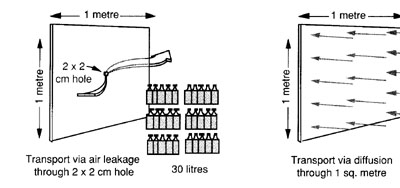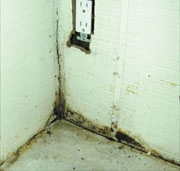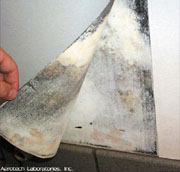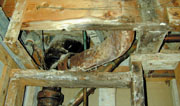
Walls and ceiling surfaces are usually where a building occupant first notices mold. Sometimes, it arises in cold spots where insulation is inadequate or has settled over time. Mold often shows up first as a stain from a water leak, gradually getting darker as the mold colonizes within the damp area. Inevitably, we all point at the wall or ceiling first, even if it is far removed from the actual source of moisture penetration and mold growth.
Drywall is also known to be “edible.” Under the right moisture conditions, the paper layers can provide food for fungus. Once drywall is contaminated with mold, it must be replaced, making mold growth inside buildings a potentially very expensive proposition.
Some designers have been moving toward the use of less edible building materials but in doing so may not be addressing the real causes of mold. Put simply, drywall doesn’t cause mold, moisture does.
Mold growth in buildings should be considered a mishap, not an inevitable consequence of age. Such mishaps are fully preventable and fully fixable. The more every contractor knows about how to prevent mold growth, the more likely we are to build good buildings that stay free of microbial contamination.
The building market has already come to its own conclusion. People don’t want to be in a building that’s polluted or moldy. If there is a way of building that will avoid indoor pollution and mold, we should be using it.

The mechanisms of mold growth
Many published articles (e.g. Toxic Mold: A Common-Sense Approach to an Uncommon Challenge, Walls and Ceilings, July 2002) have described mold’s need for moisture. One of the primary purposes of a building is to prevent moisture from intruding in our lives—we all prefer a roof that doesn’t leak. Well-built and well-maintained buildings don’t get wet inside.Still, many buildings do get wet inside in a number of different ways:
• Water can fall or drip in from leaks in the roof or exterior walls (by gravity).
• Water can be sucked in through exterior materials that are exposed to rain (by capillary action) or through basement materials exposed to wet earth.
• Moisture-laden air can be blown in (or out) through cracks in the building envelope (air leakage).
• Water vapor can wander in and out slowly by diffusion, molecule by molecule, as it moves from a more humid area to a less humid area.
• And, of course, water can also be spilled (plumbing leaks, sloppy kitchen work, playful children in bathtubs, plant growth, faulty appliances, excessive mopping, fire fighting, etc.).
The challenge for any building designer and owner is to exclude, deflect or otherwise harness all of these moisture flows so that they don’t cause damage. In actual practice, it turns out that a combination of common sense and modern building science can effectively meet this challenge.
How do buildings end up moldy? The problem is that it takes only one small mistake to cause a moisture problem inside a building. Sometimes, mistakes are made when a building is designed. For example, a missing roof closure detail can allow rain to enter a building under adverse wind conditions. Or designs that work well in one climate are mistakenly applied in another (e.g. houses designed for operating in cold winter conditions don’t make good houses for air conditioning in humid southern climates).
Sometimes, the building design is excellent, but the contractor doesn’t follow it closely enough and mistakes aren’t caught by the architect or building inspector.
Some school buildings, for example, have developed moisture problems because the pavement grade in the surrounding play area was allowed to slope toward, rather than away from, the classrooms.
Sometimes, buildings are used for purposes other than for what they were originally designed. A building, for instance, formerly used for cheese making or flower cultivation, may lack adequate ventilation when it is converted for an industrial or hobby activity.
Good buildings fall into disrepair because of declining budgets, absentee landlords, mismanagement or other reasons. Case in point—some schools have high humidity and poor indoor air quality because ventilation fans or exhaust vents have broken and have not been repaired.
Why use a systems approach to building design?
Mold arises in buildings because many people do things without looking at the bigger picture. “Building science” and “systems approach” are words used to describe a new way of designing, building and operating buildings that keeps a steady focus on the total performance of a building.
The University of Toronto’s Building Science Program emphasizes in its continuing education literature that failure to consider the bigger picture can lead to building failure:
“Schools of engineering typically teach building science in a fragmented manner, consisting of discrete elements of material science, structural design, mechanical systems, etc. Schools of architecture typically take a more integrated approach to teaching building design, but subjects related to building science are often viewed as too technical in nature. This has left an education gap within the ranks of engineers and architects practicing in the construction industry, where the building must be considered as a system. When the interaction of the many different elements and components of a building and the environments to which they are exposed are not considered as a whole, building failures can and do result.”
The systems approach to building science acknowledges the interdependence of the component materials, the mechanical and electrical systems, how the building is operated, how the environment affects the building and how the occupants use the building.
In a systems approach, building designers attempt to understand the operating characteristics of each part of the building and of the building as a whole. Changes aren’t introduced in one component material or subsystem without evaluating their impact on other aspects of a building’s overall performance.
In a well-designed building, all the materials and subsystems knit together to ensure the whole building works well, similar to a “team approach” in sports. This can be accomplished in practice by establishing good communication among all the designers, builders and potential users of a building, so that no person can change any one aspect without considering its impact on the rest.
For example, cutting school maintenance budgets in order to save a dollar now can lead to significant human illness, further expense and considerable disruption. Choosing the cheapest materials and building envelope designs can drastically reduce the useful life of a building, through wall deterioration from moisture transport, condensation and mold growth.
Sometimes, moisture-impervious finishing materials are used in air-conditioned spaces within air-leaky buildings in warm humid climates, to make walls easier to clean. Using them in this application, however, can trap moisture inside the wall causing mold growth and drywall failure over time. In short, quality buildings require lots of good thinking, before they are built and after the occupants move in. Take shortcuts at your own peril.

Guidelines to avoid mold growth
Use a full rain-screen around the entire building. It sounds simple but there’s an art to making a building shed every bit of rain possible. Adequate protection is required in the outer building layers so that driving rain will not penetrate the building. This requires appropriate rain-screen materials and additional flashing to direct any water that might penetrate under severe weather, back to the outside through a “drainage plane.”Building scientists like Joe Lstiburek, of Boston, emphasize that nothing is perfect. One should expect some water leakage and design a building to direct it back out, so it will dry out again.
Buildings work best when there is good foundation drainage, good guttering around the roof, and proper sloping of all ground surfaces and walkways away from the building, so that water won’t be directed into the building below grade. Inside, adequate drainage is a must in areas that use water—for example, a laundry or utility area. If the water table is high, a building may also need one or more sump holes and pumps, which activate in an emergency to keep water from entering a basement below grade.
Older-style construction allows a great deal of air leakage through outside walls and ceilings (the building envelope). People used to think this was a good thing because it provided air for the furnace and helped to dilute indoor pollutants. But air leakage through the building envelope can allow moisture to condense within the walls and ceilings, depending on the outdoor temperature and humidity. In northern (winter) climates, moisture-laden air going out through walls can cause condensation when it reaches the cold outer layers of the wall. In southern climates, warm, humid outside air leaks inward and can cause condensation when the air reaches air-conditioned materials inside (e.g. the backside of drywall, or cold air-conditioning ducts).
Modern buildings use direct-vent furnaces, tight wall construction, low-emission materials and deliberate ventilation rather than air leakage through walls and ceilings. If there is a proper air barrier in all walls and ceilings, there is no way for moisture-laden air to move back and forth across the “building envelope.” Without such moisture transport, there can be no condensation and mold growth within the walls and ceilings.
All buildings need ventilation to remove stale air and excess moisture produced during the normal activities of daily living. Without adequate ventilation, moisture and indoor pollutants accumulate. With leaky construction, ventilation may be adequate to remove pollutants but may lead to condensation and mold growth. With tight-wall construction using low-emission materials, ventilation can be much more efficient and is often combined with energy recovery in an exchange between intake and exhaust air.
Using a systems approach and designing high-quality buildings was once a very cumbersome and expensive proposition (although never more expensive than building failure). Today, we have access to new materials and methods that make it easier to apply the principles outlined above and to achieve mold-free buildings.

Overturn old building practices
New approaches to building that will prevent mold growth are challenging conventional building practices throughout North America. For example, it used to be standard practice in warm humid areas, to put the air-conditioning equipment and ducting in the attic and then ventilate the attic so that it wouldn’t get unbearably hot.The problem with ventilating with warm humid air is that the moisture seeks out any cold surface (e.g. an unwrapped A/C duct) and condenses. Months of dripping lead to mold growth in the insulation and drywall beneath. Eventually, the entire attic and ceiling require fixing. Some manufacturers recommend the newer practice of sealing the attics in humid climates and applying soft-foam insulation to the underside of the roof, forming a cathedral ceiling. This turns the attic into a dry, conditioned space, significantly improving the efficiency of the air-conditioning and preventing condensation and mold growth.
Designers and building code regulators are also being challenged to rethink their insulation guidelines, which used to include ever-higher thicknesses and R-values in the colder areas of the continent. Since the value of insulation is defeated by airflow through it, it makes sense that adequate insulation in a well-sealed wall may be just as good or better than much more insulation in a wall that leaks like a sieve.
Hotel owners in southern U.S. regions used to curse the fact that vinyl wall coverings had to be replaced every few years. Why? Moisture leaking through the building envelope from the outside would penetrate the drywall and condense within it, right behind the wallpaper, which was impervious to moisture. Inevitably, the back surface of the wall covering would become black with mold growth and begin to peel. Owners would rip it off, scrape it down and install more of the same.
Now that there is greater understanding of moisture flow, condensation and the dangers of mold growth, people are also rethinking the concept of vapor barriers, which must be on the warm side of the insulation, not the cold side.
If you put a vapor barrier on the wrong side, or on both sides, moisture may get trapped and the wall between may never dry out. If a good vapor barrier is used in the right place (warm side) in combination with a well-sealed building envelope, there is very little moisture transport across the wall or ceiling.
In a properly designed wall, any residual moisture that does pass through or around the vapor barrier can continue through the wall by diffusion and causes no harm.
In warm climates, small amounts of residual moisture can, for example, be easily handled by the drying effect of air conditioning if the moisture is allowed to migrate completely through the wall into the interior space. In cold climates, residual moisture can reach the exterior without causing damage, if the outer layers of the wall are permeable to moisture flow.
As long as the walls and ceilings are sufficiently airtight, we are not as dependent on vapor barriers as before to avoid condensation and mold growth. In fact, in some climates and applications, vapor barriers may turn out to be unnecessary and even undesirable.
Remediate existing buildings
Just as mold growth can be prevented in new construction by prudent design, good thinking and lots of co-ordination among the many parties involved, buildings that have developed mold problems can be properly remediated, if appropriate care is taken. The following example illustrates how moldy buildings can be returned to use.Problems were encountered soon after the occupation of three intermediate schools in Texas in the form of flare-ups of mold allergies. Mold was first discovered behind wall hangings and marker boards in several rooms. An investigation revealed numerous flaws that allowed water to penetrate into the walls.
The consultants recommended that all existing materials containing mold should be removed and that the existing exterior building envelope be modified to provide for the proper control of moisture entry, accumulation and removal.
Repairs were made to the roof, gutters, downspouts, grading, windows, flashing and weep-holes to ensure that rainwater could no longer penetrate the walls or roof.
The moldy inside walls were removed and both the interior and exterior surfaces of the exterior masonry walls were moisture-proofed. Three inches of foam insulation were applied directly to the inside face of the exterior masonry veneer and then the interior walls were rebuilt.
The cardinal rule in avoiding involvement in a lawsuit is: “Don’t do anything you know is dead wrong.” Painting over moldy drywall in the hope that the mold will go away is one such example. Installing the wall finish before the roof is sealed is another. In buildings, covering up mold problems just doesn’t work—mold will continue to thrive and will rise to the surface again, literally.
Subcontractors won’t shoulder the full responsibility for the building’s overall performance, but their reputation may still suffer if others haven’t done their job properly. The finest drywall job can be ruined overnight by leaky windows. The most decorative ceiling can be marred in minutes by a plumbing failure. Specifying vinyl coverings in the wrong application won’t help the wallpaper installer market his expertise. And all contractors lose credibility if the building goes moldy. W&C

Report Abusive Comment